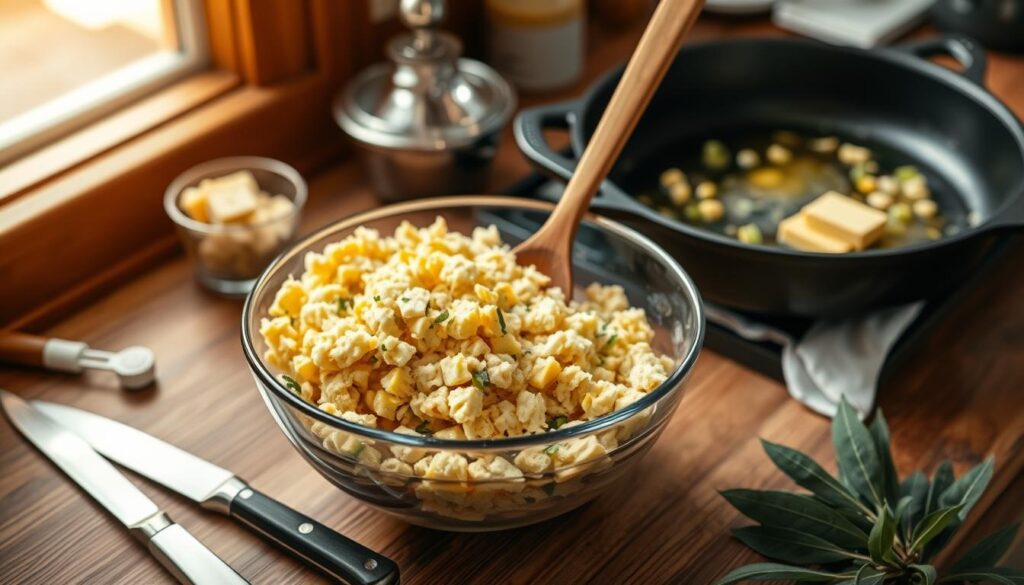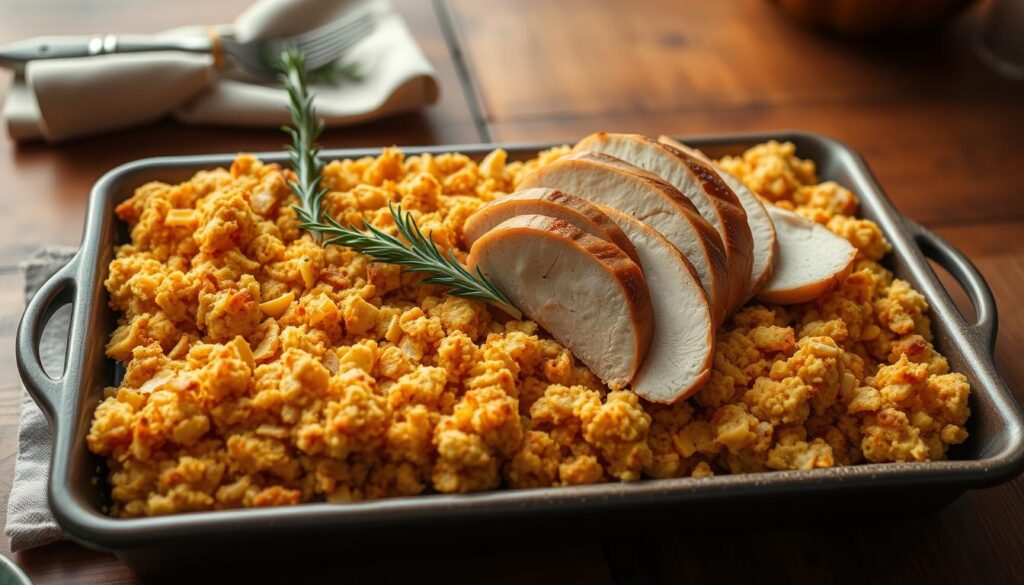Southern cuisine brings comfort and warmth to every meal, and cornbread dressing with chicken stands as a quintessential dish that captures the heart of traditional cooking. This classic recipe transforms simple ingredients into a magnificent culinary experience that connects families during holiday gatherings and special occasions.
When you explore southern cornbread dressing, you’ll discover a rich tapestry of flavors rooted in generations of home cooking. The combination of crumbly cornbread, tender chicken, and perfectly balanced seasonings creates a dish that transcends ordinary side dishes. Whether you’re a seasoned cook or a kitchen novice, this recipe from luyarecipes.com will guide you through creating an unforgettable southern classic.
Table of Contents
The History of Southern Cornbread Dressing
Southern cornbread dressing represents a cherished culinary tradition deeply rooted in American Southern cooking. This beloved dish tells a story of resourcefulness, cultural heritage, and family recipes passed down through generations.
Traditional cornbread dressing emerged from practical kitchen wisdom. Early Southern cooks transformed leftover cornbread into a hearty side dish that could feed large families during challenging times. Slaves and poor rural families developed innovative cooking techniques that maximized available ingredients.
Origins in Southern American Cuisine
Native American corn cultivation significantly influenced Southern cooking. Cornbread became a staple food, with families creating unique recipes that reflected local ingredients and cultural backgrounds. Southern cornbread dressing evolved from simple bread-based stuffings to complex, flavorful dishes.
“Food is our common ground, a universal experience.” – James Beard
Evolution from Simple Stuffing to Complex Dressing
Early stuffings were basic mixtures of bread, herbs, and broth. Southern cooks gradually incorporated regional ingredients like sage, celery, and onions. The traditional cornbread dressing transformed from a practical meal extension to a celebrated holiday centerpiece.
Regional Variations and Influences
Different Southern regions developed unique cornbread dressing styles. Coastal areas might include seafood, while inland communities used more chicken or sausage. Each family’s recipe became a treasured culinary signature, representing local traditions and personal history.
Essential Ingredients for Perfect Cornbread Dressing with Chicken
Creating an exceptional cornbread dressing with chicken starts with selecting the right ingredients. Your homemade cornbread stuffing requires careful consideration of each component to ensure maximum flavor and texture.
At the heart of your recipe, high-quality cornmeal forms the foundation. Choose stone-ground cornmeal for a more authentic, rich taste that will elevate your cornbread dressing with chicken. Fresh herbs like sage, thyme, and parsley will add depth and traditional Southern character to your dish.
“The secret to great cornbread dressing is in the quality of your ingredients” – Southern Kitchen Wisdom
Your chicken selection matters tremendously. Opt for bone-in, skin-on chicken thighs or a whole roasted chicken for the most robust flavor. These cuts provide rich, juicy meat that integrates perfectly with homemade cornbread stuffing.
Essential ingredients include:
• Stone-ground cornmeal
• Fresh herbs
• Chicken stock
• Celery
• Onions
• Eggs
• Butter
• Salt and pepper
By carefully selecting and combining these ingredients, you’ll create a cornbread dressing that brings warmth and tradition to your table.
Kitchen Tools and Equipment You’ll Need
Crafting an easy chicken cornbread dressing requires the right kitchen equipment. Proper tools can transform your cooking experience from challenging to straightforward. Having the correct utensils ensures your dressing turns out perfectly every time.
Preparing your easy chicken cornbread dressing becomes much simpler when you have the essential tools ready. Professional and home cooks alike understand that quality equipment makes a significant difference in recipe success.
Essential Baking Dishes
Your baking dish is crucial for creating delicious cornbread dressing. A 9×13 inch ceramic or glass baking dish works best. These dishes distribute heat evenly, helping your chicken cornbread dressing cook uniformly and develop a golden-brown top.
Mixing and Preparation Tools
Gather large mixing bowls, a sturdy whisk, and measuring cups for precise ingredient combinations. A sharp chef’s knife helps prepare chicken and chop herbs. Wooden spoons are perfect for gently mixing your easy chicken cornbread dressing without overworking the ingredients.
Temperature Control Equipment
An accurate meat thermometer ensures your chicken reaches safe cooking temperatures. An oven thermometer helps verify your oven’s actual temperature, preventing under or overcooking your cornbread dressing.
“The right tools can turn a good recipe into a great meal.” – Professional Chef
Making the Perfect Homemade Cornbread Base
Creating the foundation for your best cornbread dressing recipe starts with a perfect homemade cornbread base. Unlike store-bought options, homemade cornbread brings depth and authentic flavor to your stuffing that can’t be replicated from a box.
Your cornbread should be slightly dry and crumbly, which helps absorb the delicious seasonings and moisture in your homemade cornbread stuffing. Traditional Southern recipes recommend using stone-ground cornmeal for a more robust texture and rich corn flavor.
“A great cornbread is the secret weapon of any authentic Southern kitchen.” – Southern Cooking Traditions
Key ingredients for your cornbread base include yellow cornmeal, flour, baking powder, salt, eggs, buttermilk, and a touch of sugar. Bake your cornbread a day ahead, allowing it to cool and slightly dry out. This preparation technique ensures your cornbread will perfectly crumble and mix with other ingredients.
Pro tip: Cast iron skillet baking creates a crispy exterior that adds incredible texture to your best cornbread dressing recipe. The skillet’s heat distribution guarantees an evenly cooked, golden-brown cornbread that will become the star of your holiday meal.
Preparing and Seasoning the Chicken
Creating a delicious cornbread dressing with chicken starts with selecting and preparing the perfect protein. The right chicken preparation can elevate your savory cornbread dressing from good to exceptional.
Selecting the Best Chicken Parts
When making cornbread dressing with chicken, choose meat that brings maximum flavor. Chicken thighs work best due to their rich, tender meat and higher fat content. Boneless, skinless thighs provide the most convenient option for your savory cornbread dressing.
Mastering Flavor Techniques
Seasoning is crucial for a memorable dish. Create a robust spice blend using kosher salt, black pepper, garlic powder, and dried herbs like thyme and sage. Pat the chicken dry before seasoning to ensure a perfect crust and deep flavor penetration.
“The secret to an incredible cornbread dressing is in the seasoning of the chicken.” – Southern Cooking Experts
Cooking Methods for Perfect Texture
Roasting or pan-searing chicken provides the best results for your cornbread dressing. Cook the chicken until it reaches an internal temperature of 165°F. Let it rest before chopping to maintain moisture and enhance the overall texture of your savory cornbread dressing.
Step-by-Step Instructions for Traditional Cornbread Dressing

Creating the perfect traditional cornbread dressing requires careful attention to detail and a passion for Southern cooking. Start by crumbling your homemade cornbread into a large mixing bowl. The key to an authentic southern cornbread dressing is using day-old cornbread that’s slightly dried out.
Next, sauté diced onions and celery in butter until they’re soft and fragrant. These vegetables are crucial for developing the rich flavor profile of your traditional cornbread dressing. Combine the sautéed vegetables with your crumbled cornbread, adding chopped fresh herbs like sage and thyme.
“The secret to a great Southern cornbread dressing is in the details and family tradition.” – Southern Cooking Expert
Whisk together chicken broth, eggs, and your favorite seasonings. Pour this mixture over the cornbread and vegetable blend, mixing gently to maintain some texture. Be careful not to overmix, as this can make your dressing too dense.
Transfer the mixture to a greased baking dish, spreading it evenly. Bake at 375°F for about 35-40 minutes, or until the top is golden brown and crispy. Your southern cornbread dressing should have a moist interior with a slightly crunchy top that delivers authentic Southern comfort.
Tips for Achieving the Perfect Texture
Creating the best cornbread dressing recipe requires careful attention to texture. Your savory cornbread dressing can easily go from delightful to disappointing if you don’t master a few key techniques.
Moisture is the secret weapon in developing an incredible dressing. Too dry, and your dish becomes crumbly and unappealing. Too wet, and you’ll end up with a mushy mess that lacks the signature cornbread dressing appeal.
Controlling Moisture Like a Pro
Start by preparing your cornbread slightly on the drier side. This helps absorb additional liquid without becoming soggy. Use chicken broth sparingly, adding it gradually to achieve the perfect consistency. A good rule of thumb is to stop adding liquid when the mixture holds together but isn’t swimming in moisture.
Master Mixing Techniques
When combining ingredients for your savory cornbread dressing, use a gentle folding motion. Overmixing can compact the bread and create a dense texture. Aim for a light, airy mixture that will bake into a tender, flavorful dish.
Baking for Perfection
Temperature and timing are crucial in the best cornbread dressing recipe. Bake at 350°F for about 45 minutes, covering with foil if the top browns too quickly. The goal is a golden-brown top with a moist, tender interior that melts in your mouth.
“The difference between good and great dressing is in the details.” – Southern Cooking Wisdom
Make-Ahead and Storage Instructions
Planning ahead can make your Thanksgiving cornbread dressing preparation much smoother. You can prepare your easy chicken cornbread dressing up to two days before the big meal. Start by baking the cornbread and chopping ingredients in advance, storing them separately in airtight containers in the refrigerator.
“Prep work is the secret to stress-free holiday cooking!” – Southern Kitchen Wisdom
For best results, assemble your Thanksgiving cornbread dressing the day before serving. Cover the unbaked dressing tightly with aluminum foil and refrigerate. When you’re ready to serve, remove from the refrigerator 30 minutes before baking to allow it to come to room temperature.
Storage is crucial for maintaining the delicious flavor of your easy chicken cornbread dressing. Cooked dressing can be refrigerated for 3-4 days. To reheat, cover with foil and warm in a 350°F oven for 20-25 minutes. Avoid microwaving, which can make the dressing soggy and compromise its texture.
Pro tip: If you want to freeze your cornbread dressing, do so before baking. Wrap it tightly in plastic wrap and then aluminum foil. Frozen dressing can be stored for up to one month. Thaw in the refrigerator overnight before baking as directed in your original recipe.
Serving Suggestions and Complementary Dishes
Your Thanksgiving cornbread dressing deserves a grand stage. Creating the perfect meal goes beyond just the main dish. Southern cornbread dressing shines brightest when paired with complementary flavors and thoughtful presentation.

Elevate your southern cornbread dressing by selecting side dishes that enhance its rich, savory profile. Classic accompaniments like roasted turkey, green bean casserole, and cranberry sauce create a balanced plate that celebrates traditional Southern cuisine.
Classic Side Pairings
When serving Thanksgiving cornbread dressing, consider adding roasted sweet potatoes, honey-glazed carrots, and collard greens. These vegetables complement the hearty dressing while adding vibrant colors and nutritional variety to your meal.
Garnishing Techniques
Transform your southern cornbread dressing into a visual masterpiece. Sprinkle fresh chopped parsley, chives, or crispy sage leaves on top. A light drizzle of warm gravy can add an elegant touch that makes your dish look professionally prepared.
Presentation Tips
“Good food is all about creating memories around the table” – Southern cooking wisdom
Choose serving dishes that highlight your cornbread dressing’s texture and color. White ceramic platters or rustic wooden boards can make your dish look inviting. Serve warm and garnish just before bringing to the table to maintain maximum appeal.
Troubleshooting Common Issues
Making the perfect homemade cornbread stuffing can be tricky. Even experienced home cooks encounter challenges when preparing cornbread dressing with chicken. Knowing how to solve common problems will help you create a delicious dish every time.
Dry dressing is a frequent issue many cooks face. If your homemade cornbread stuffing feels too crumbly, add extra chicken broth or beaten eggs to restore moisture. Start with small amounts and mix thoroughly. The key is achieving a moist but not soggy consistency that holds together when spooned.
“The secret to great cornbread dressing is balance – not too wet, not too dry.” – Southern Cooking Experts
Seasoning problems can make or break your cornbread dressing with chicken. If the flavor seems bland, boost it with additional herbs like sage, thyme, or poultry seasoning. Salt and pepper can also help enhance the overall taste. Always taste and adjust seasonings before baking.
Texture troubles can arise from improper mixing or baking. Overmixing can lead to dense, tough dressing. Gently fold ingredients together and avoid compressing the mixture. For a crispy top and moist interior, cover with foil during part of the baking process, then uncover to create a golden-brown crust.
By understanding these troubleshooting techniques, you’ll be able to rescue your homemade cornbread stuffing and impress your dinner guests with a perfect side dish.
Conclusion
Creating the best cornbread dressing recipe is more than just following instructions—it’s about embracing a cherished Southern tradition. Your journey through this traditional cornbread dressing experience connects you to generations of family kitchen memories and culinary expertise.
The art of preparing an authentic Southern cornbread dressing requires patience, love, and attention to detail. Each step you’ve learned—from selecting the perfect chicken to mastering the cornbread base—brings you closer to a dish that represents comfort and home-cooked warmth.
For more delectable Southern recipes and cooking inspiration, explore luyarecipes.com. Passionate home cooks can dive deeper into culinary traditions by following our Pinterest account at pinterest.com/, where you’ll discover endless recipe variations and cooking tips to elevate your kitchen skills.
We encourage you to experiment, adapt, and make this traditional cornbread dressing recipe your own. Your unique touch will transform a classic dish into a personal culinary masterpiece that tells your family’s story through every delicious bite.
FAQ
What makes Southern cornbread dressing different from other stuffing recipes?
Southern cornbread dressing is unique because it uses crumbled cornbread as its base, creating a richer, more flavorful foundation compared to traditional bread-based stuffings. The use of buttermilk, sage, and a blend of herbs gives it a distinctive Southern flavor profile that sets it apart from other regional stuffing variations.
Can I make cornbread dressing with chicken ahead of time?
Absolutely! You can prepare your cornbread dressing with chicken up to two days in advance. Simply assemble the dish, cover it tightly, and refrigerate. When you’re ready to serve, bake it in the oven until it’s heated through and the top is golden brown. This make-ahead approach can be a lifesaver during busy holiday preparations.
What are the key ingredients for a traditional Southern cornbread dressing?
The key ingredients include homemade cornbread, chicken or turkey broth, eggs, diced onions, celery, fresh sage, thyme, salt, black pepper, and cooked chicken. Some recipes also incorporate buttermilk for extra moisture and flavor. The combination of these ingredients creates the classic Southern dressing that’s both savory and comforting.
How do I prevent my cornbread dressing from becoming too dry?
To keep your cornbread dressing moist, use plenty of chicken broth or stock when mixing the ingredients. Add the broth gradually and mix until you achieve a moist but not soggy consistency. Cover the dish with foil while baking for the first part of the cooking time, and only remove the foil towards the end to create a crispy top.
Can I make a vegetarian version of cornbread dressing?
Yes, you can create a vegetarian version by replacing the chicken with vegetable broth and adding additional vegetables like mushrooms, roasted vegetables, or vegetarian sausage. The cornbread base remains the same, and you can still achieve a rich, flavorful dressing without meat.
What’s the best way to store leftover cornbread dressing?
Store leftover cornbread dressing in an airtight container in the refrigerator for up to 4 days. When reheating, cover the dish with foil and warm in a 350°F oven until heated through. Add a little extra broth if the dressing seems dry to help restore its moisture and prevent it from becoming too crisp.
How can I make my cornbread dressing more flavorful?
Enhance the flavor by using homemade cornbread, adding fresh herbs like sage and thyme, incorporating sautéed onions and celery, and using a rich, seasoned chicken or turkey broth. Some cooks also add a splash of white wine or use herbs like rosemary to create more complex flavor profiles.
Is cornbread dressing only for Thanksgiving?
While cornbread dressing is a Thanksgiving classic, it’s delicious year-round. Many Southern families enjoy it with roasted chicken, as a side dish for Sunday dinners, or during other holiday meals. Its versatility makes it a beloved dish that can be enjoyed at any time of the year.









